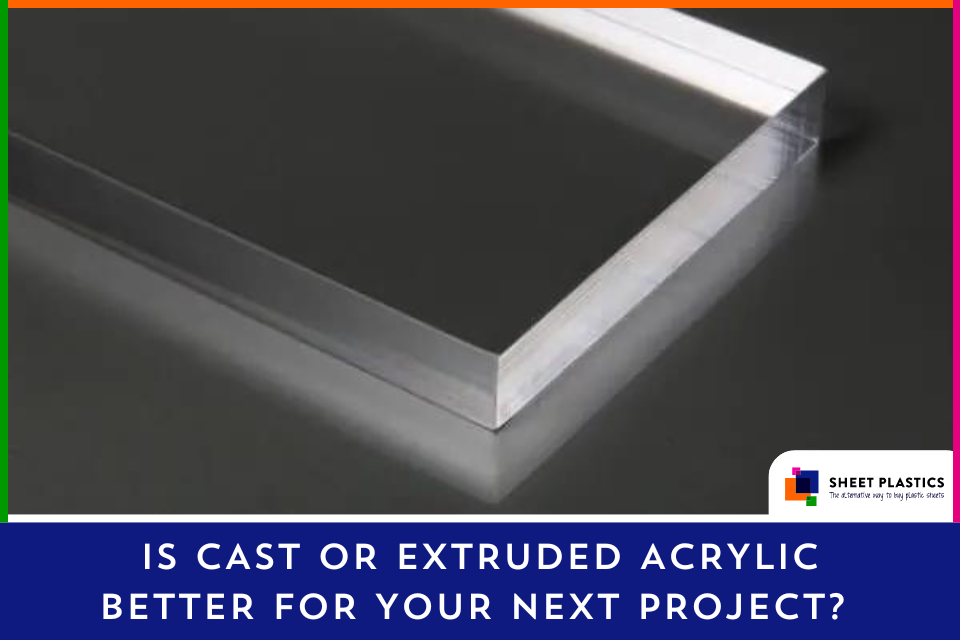Cast vs Extruded Acrylic Sheets

Acrylic, otherwise known as plexiglass or acrylic glass, is a transparent thermoplastic that has broad uses throughout various industries as an alternative to glass. Going by the scientific name Polymethyl Methylcrylate, its most prominent qualities - those that make it such a useful material - are its clarity, shatter-resistance, and lightweight nature.
Wherever you might encounter plexiglass, you will find that it will be one of two types defined by their production method. These are cast acrylics and extruded acrylics. In this piece, we'll be taking a closer look at these two types of plexiglass, delving into what differentiates them, what they're most suited for, and when to choose one over the other for your needs.
Let's get right into it.
Cast Acrylic Sheets
These are acrylic sheets made from pouring out the liquid ingredients that makeup acrylic (methyl methacrylate, monomer, and initiators) into forms or molds. These are then allowed to set into the desired shape. The result is a high optical quality product that is superior in strength and durability to glass without sacrificing its clarity.
Benefits of cast acrylic sheets include:
- Superior chemical resistance, demonstrated by their resistance to crazing (the formation of tiny networks of cracks) when exposed to corrosive substances or solvents
- Superior capacity to be reworked under high-temperature settings
- Higher optical properties and surface finish
- A broader range of thermoforming applications
Extruded Acrylic Sheets
On the other hand, these types of sheets are manufactured through a process involving the pushing of acrylic pellets through extrusion dies that are highly polished to produce the finished product. Extruded acrylic sheets are more universally popular due to their cost-effectiveness. While you might have trouble spotting the difference between extruded and cast acrylics, cast acrylics are significantly more expensive.
Benefits of extruded acrylic sheets include:
- Lower viscosity while under high-temperature scenarios makes them more ductile
- Reduced mechanical properties make them more amenable to manufacturing processes such as heating, bending, and vacuum forming.
- Excellent optical properties that make them clear as glass at a fraction of the weight and cost.
- A lower melting point compared to cast acrylic allows for greater malleability, and it will bond and flame polish more effectively. The finished product of the extruding process will be much more durable than cast acrylic sheeting, as any minor imperfections such as scratches can be easily buffed or polished away.
Differences Between Cast and Extruded Acrylic Sheets
The different manufacturing processes that these two variants undergo are what imbue them with differing properties. While these properties or qualities might not be readily apparent to the naked eye, they make a big difference in determining what uses they are best suited for. Major differences include:
Thermal Stability
Acrylic sheets made through the casting method are more resistant to high temperatures. Its high thermal stability standpoint means it will not chip, melt, or rust during routing, although this property may sometimes present difficulties during fabrication. On the other hand, Extruded acrylic sheets will soften when temperatures rise beyond the 195 degrees Fahrenheit point, making it much more cost-effective to rout, cut, and polish.
Contamination Susceptibility
Owing to their lower melting point, extruded acrylic sheets are less likely to incur contamination in the form of lint, dirt, and other particulates during the production process. This quality is also what makes extruded sheets more suitable for thermoforming and cementing than cast acrylic sheets.
Thickness
Due to their production method, extruded sheets tend to show much greater uniformity across their lengths (almost zero variation). On the other hand, Cast acrylics will tend to have a more significant variation in thickness across their length, which may sometimes make processing and fabrication less accurate.
Cost
Generally speaking, you will find that extruded acrylics sell for much cheaper than cast acrylic sheets. Even in cases where retailers, whether online or in real-world outlets, do not indicate the sheet difference, expect to find cast sheets selling at almost double the price of extruded sheets, which means you can figure out which is which.
Making Use of Cast vs Extruded Acrylic Sheets
Plexiglass is useful in a wide variety of industries and has found numerous applications. However, different purposes will typically call for different types of acrylic sheeting depending on various factors, even though some overlap may be observed.
Generally speaking, you will find cast and extruded acrylic sheeting being used for applications such as general signage, laser cutting, laser engraving, cabinet lightboxes, POP retail graphics, channel letters, wayfinding signs, building signs, dimensional signage, and more.
On the other hand, Extruded acrylic sheets will more likely be employed in program jobs that require consistent lighting, digital prints, pan-formed sign faces, framing, dimensional signage, cabinet lightboxes, and building signs, and more.
Why Choose Sheet Plastics?
We aim to help you get things done in the most efficient, cost-effective, and satisfying way possible. To this end, we offer cut-to-size acrylic sheets that ensure you don't spend a nickel more than you need to and provide free ground shipping on small standard products. Our plastic specialists are expert fabricators, and you're welcome to avail yourself of our sample service to gain a better idea of what you're ordering. Get in touch with us today!







